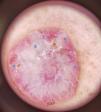A 68-year-old man with no family or personal past history of interest consulted with a nonulcerated tumorous lesion that had appeared 3 years earlier on the left side of the torso. Clinical examination revealed a nonulcerated, pearl-like sessile tumor with a maximum diameter of 1.2cm and superficial telangiectasia (Fig. 1). Dermoscopy revealed whiteish areas, fine arboriform blood vessels, whiteish striations, and follicular keratotic plugs (Fig. 2). Histology supported the clinical diagnosis of fibroepithelioma of Pinkus (FeP).
CommentThe first reported cases of FeP were published in 1953 by Herman Pinkus and described as premalignant fibroepithelial skin tumors. Whether it is a rare variety of basal cell carcinoma (BCC) or a benign adnexal tumor with follicular differentiation has been the subject of debate for some time.1 The latest hypotheses situate the entity as an intermediate form between trichoblastoma and BCC, with difficult clinical diagnosis and particularly slow growth.2
FeP is more frequent in middle-aged patients, has no predilection for sex, and is mainly located on the torso. It usually presents as a nodule, and occasionally a plaque, that is well-demarcated, solitary, sessile and firm, smooth, slightly raised, flesh-colored or pink, asymptomatic, and slow-growing. Other clinical forms have been reported, such as more pedunculate, polypoid, giant, and ulcerated forms, as well as brown or grayish forms. The differential diagnosis should include skin tags, intradermal melanocytic nevus, neurofibroma, and seborrheic keratosis.
In 2005, Zalaudek et al. provided the first dermoscopic descriptions of FeP, which would later become differentiated dermoscopic patterns.3,4
All the lesions examined in that study were red to yellowish light brown, associated with long, linear, irregularly distributed telangiectasia. This vascular pattern, consisting of smaller-caliber arborescent telangiectasia with fewer ramifications, differs clearly from the vascular pattern of BCC. Other notable characteristics of that pattern to consider are the presence of whiteish striations that sometimes cover larger areas or form a honeycomb pattern, indicating a highly collagenized or fibrotic stroma (90% of reported cases), brownish-grey unstructured pigmentation, punctate vessels and milia-like cysts, and follicular keratotic plugs.
A new pattern has recently been reported, consisting of whiteish reticular lines (inverted reticular pattern or reticular depigmentation), as can be observed in nevi, particularly Spitz nevus, melanoma, and some forms of dermatofibroma.5 Some authors have even considered it to be a dermoscopic simulator of malignant melanoma.6
We consider dermoscopy to be a useful tool for supporting the clinical diagnosis of this type of lesion.
Conflicts of InterestThe authors declare that they have no conflicts of interest.
Please cite this article as: Cuenca-Barrales C, Ruiz-Carrascosa JC, Ruiz-Villaverde R. Fibroepitelioma de Pinkus: un carcinoma basocelular con una dermoscopia distintiva. Actas Dermosifiliogr. 2018;109:908–909.








